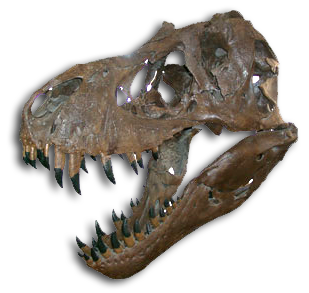Item Number
855
Type
image
Description
Hard Pine
Size
13x11
Age
Eocene, Clarno Fm
SciId
Genus: Pinus, Family: Pinaceae
Status
in inventory
Display/Storage
Display
Building
Zuhl Museum
Original Site
Hampton Butte, Oregon
Date Acquired
1981
Source
Burnett
Gallery/Room\Floor
Petrified Wood Gallery
Notes
Notes from Dr. Scott Singleton, Houston Museum, 2005:Hard Pine Genus: Pinus Family: Pinaceae (Pine) Hampton Butte, Deschutes Co., central Oregon Formation: Clarno Fm. Age: middle Eocene, ~44 million years Distinguishing Characteristics: Growth rings apparent due to a distinct difference in cell size through the growth ring. This is in contrast to the Soft Pine subgroup which has only a small change in cell size between earlywood and latewood. Pines are distinguished from other conifers by the presence of large, single resin vessels scattered throughout the growth ring. Environment of Deposition: The middle Eocene is characterized by a globally warm climatic interval. The Clarno Fm. assemblage is very diverse and contains only warm, subtropical genera, similar to present day Southeast Asia. Clarno sediments are typically either ash beds or coarse to fine-grained sands deposited in terrestrial lakes, streams, or flood-event environments. The ash beds have been attributed to lahar deposits, which are volcanic mud and debris flows. Fossilized wood occurs throughout the formation in a variety of sediments. Some specimens are highly abraded from transport in streams or floods prior to fossilization. Some wood occurs as upright, in-situ petrified forests preserved by massive lahar deposits.
Preview

Description
Notes from Dr. Scott Singleton, Houston Museum, 2005:Hard Pine Genus: Pinus Family: Pinaceae (Pine) Hampton Butte, Deschutes Co., central Oregon Formation: Clarno Fm. Age: middle Eocene, ~44 million years Distinguishing Characteristics: Growth rings apparent due to a distinct difference in cell size through the growth ring. This is in contrast to the Soft Pine subgroup which has only a small change in cell size between earlywood and latewood. Pines are distinguished from other conifers by the presence of large, single resin vessels scattered throughout the growth ring. Environment of Deposition: The middle Eocene is characterized by a globally warm climatic interval. The Clarno Fm. assemblage is very diverse and contains only warm, subtropical genera, similar to present day Southeast Asia. Clarno sediments are typically either ash beds or coarse to fine-grained sands deposited in terrestrial lakes, streams, or flood-event environments. The ash beds have been attributed to lahar deposits, which are volcanic mud and debris flows. Fossilized wood occurs throughout the formation in a variety of sediments. Some specimens are highly abraded from transport in streams or floods prior to fossilization. Some wood occurs as upright, in-situ petrified forests preserved by massive lahar deposits. 11x11
Keywords
Hard Pine Notes from Dr. Scott Singleton, Houston Museum, 2005:Hard Pine Genus: Pinus Family: Pinaceae (Pine) Hampton Butte, Deschutes Co., central Oregon Formation: Clarno Fm. Age: middle Eocene, ~44 million years Distinguishing Characteristics: Growth rings apparent due to a distinct difference in cell size through the growth ring. This is in contrast to the Soft Pine subgroup which has only a small change in cell size between earlywood and latewood. Pines are distinguished from other conifers by the presence of large, single resin vessels scattered throughout the growth ring. Environment of Deposition: The middle Eocene is characterized by a globally warm climatic interval. The Clarno Fm. assemblage is very diverse and contains only warm, subtropical genera, similar to present day Southeast Asia. Clarno sediments are typically either ash beds or coarse to fine-grained sands deposited in terrestrial lakes, streams, or flood-event environments. The ash beds have been attributed to lahar deposits, which are volcanic mud and debris flows. Fossilized wood occurs throughout the formation in a variety of sediments. Some specimens are highly abraded from transport in streams or floods prior to fossilization. Some wood occurs as upright, in-situ petrified forests preserved by massive lahar deposits. 1981 Eocene, Clarno Fm Small Slab
Keywords
Hard Pine Notes from Dr. Scott Singleton, Houston Museum, 2005:Hard Pine Genus: Pinus Family: Pinaceae (Pine) Hampton Butte, Deschutes Co., central Oregon Formation: Clarno Fm. Age: middle Eocene, ~44 million years Distinguishing Characteristics: Growth rings apparent due to a distinct difference in cell size through the growth ring. This is in contrast to the Soft Pine subgroup which has only a small change in cell size between earlywood and latewood. Pines are distinguished from other conifers by the presence of large, single resin vessels scattered throughout the growth ring. Environment of Deposition: The middle Eocene is characterized by a globally warm climatic interval. The Clarno Fm. assemblage is very diverse and contains only warm, subtropical genera, similar to present day Southeast Asia. Clarno sediments are typically either ash beds or coarse to fine-grained sands deposited in terrestrial lakes, streams, or flood-event environments. The ash beds have been attributed to lahar deposits, which are volcanic mud and debris flows. Fossilized wood occurs throughout the formation in a variety of sediments. Some specimens are highly abraded from transport in streams or floods prior to fossilization. Some wood occurs as upright, in-situ petrified forests preserved by massive lahar deposits. 1981 Eocene, Clarno Fm Small Slab


